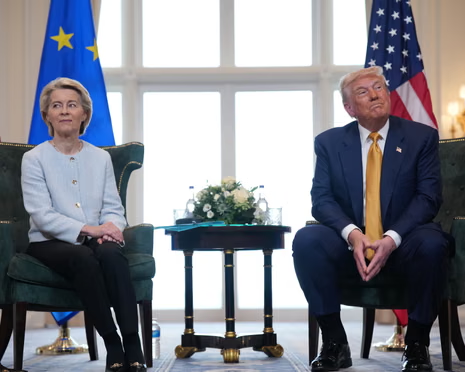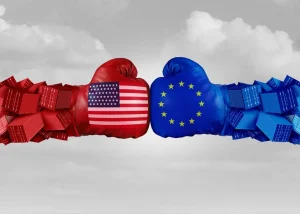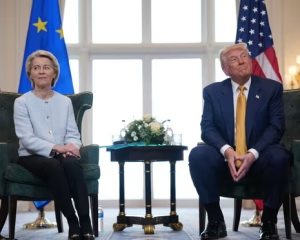Glasgow, July 31, 2025 — In what many are calling a humiliating capitulation, the European Union has bowed to the demands of U.S. President Donald Trump, agreeing to a controversial new trade deal that reshapes the transatlantic relationship in America’s favor. The deal—framed by Trump as a “historic victory for American workers”—imposes aggressive tariffs on key European exports while compelling the EU to purchase billions in U.S. energy and weapons.
Standing alongside Trump at a summit in Scotland, European Commission President Ursula von der Leyen presented the deal as a “breakthrough” in EU–U.S. relations! However, insiders and critics alike have described it as a coerced agreement, forced upon Europe under threats of harsher tariffs and economic punishment. The balance of power, once seen as mutually beneficial across the Atlantic, has tilted firmly in favor of Washington.
📜 The Deal’s Main Provisions: Europe Pays the Price
🔻 1. Tariff Asymmetry That Hurts Europe’s Industrial Core
-
Automobiles: The U.S. has locked in a 15% tariff on EU car exports, down from 25% but still economically punishing. This was achieved after Trump threatened 30% duties, a move that terrified European carmakers already dealing with EV market disruption, labor unrest, and global competition.
-
Semiconductors and Electronics: Europe’s growing high-tech sector, especially in Germany, the Netherlands, and Scandinavia, will now face 15% export tariffs to the U.S.—an enormous hurdle in a market that demands cost efficiency and innovation.
-
Pharmaceuticals: In a deeply controversial move, the U.S. will now tax lifesaving drug exports from Europe, despite their former duty-free status under WTO agreements. Trump has retained the right to raise these tariffs at will, creating long-term uncertainty for European biotech and pharma giants.
-
Steel and Aluminum: The Trump-era 50% tariff remains, continuing to crush Europe’s specialty metals industry, from German engineering hubs to Italian shipbuilders. Despite years of protest, the EU could not negotiate even partial relief.
–
💸 2. Forced Energy and Weapons Purchases
🔥 Liquefied Natural Gas (LNG): A $750 Billion Bill
The EU has agreed to purchase $750 billion worth of American LNG, despite cheaper alternatives from Algeria, Qatar, Russia, and other MENA producers. These LNG shipments are significantly more expensive, especially given transatlantic shipping costs and dollar–euro exchange volatility.
This decision effectively subsidizes the U.S. fracking industry, transferring wealth from European taxpayers and industries to American energy firms—while raising costs for EU manufacturing, transportation, and heating sectors.
🛡️ Weapons: Billions to U.S. Military Contractors
Europe’s own arms industry—led by firms like Dassault, BAE Systems, and Rheinmetall—will now lose contracts as the EU pledges to spend hundreds of billions on U.S. weapons systems, including fighter jets and missile defense platforms.
This contradicts the EU’s “ReArm Europe” strategy, which aimed to build defense self-sufficiency and reduce reliance on the United States. Instead, European taxpayers will fund American military dominance, while domestic defense jobs and innovation stagnate.
–
⚠️ How the Deal Was Imposed: Threats, Intimidation, and a Disunited Europe
🗣️ Trump’s Tactics: Pressure Over Partnership
President Trump used a combination of tariff threats, supply chain choke points, and diplomatic pressure to force this deal through. In private talks, Trump reportedly warned that the U.S. would:
-
Slap 30–35% tariffs on EU cars and machinery.
-
Block transatlantic data transfers, essential for tech and finance.
-
Limit NATO funding unless Europe made “economic concessions.”
Fearing fragmentation and economic pain, Brussels folded.
🤝 Lack of EU Unity
The EU’s failure to present a united front made it easy for Washington to exploit internal divisions. While Germany favored compromise, France advocated resistance. Eastern European nations, dependent on NATO protection, backed Trump’s position. The result? A fractured EU with no clear negotiating stance, outmaneuvered by a single, aggressive player.
📉 Future Economic Consequences for Europe
1. Export Competitiveness Erodes
Tariffs on key goods will make European products less competitive in global markets. From German luxury cars to Italian pharmaceuticals, exporters will lose ground to American and Asian rivals.
2. Higher Energy Costs
Overpriced LNG will inflate production costs, weakening the EU’s ability to compete in global manufacturing. This will hurt sectors like:
-
Automotive (Germany, Czech Republic)
-
Chemicals (Netherlands, Belgium)
-
Metals and machinery (France, Italy)
3. Stagnation in Defense Innovation
By redirecting procurement to American firms, Europe will hollow out its domestic defense sector, risking job losses, IP leaks, and long-term dependency.
4. Loss of Strategic Autonomy
Economically and militarily, the EU is signaling it cannot act independently. This perception will reduce Europe’s leverage in future trade or security negotiations—not just with the U.S., but also with China, India, Russia, and the Global South.
–
🌍 Global Reactions: Europe Seen as a Weak Actor on the World Stage
🐉 China Observes With Interest
Beijing sees the EU’s retreat as an opportunity to strengthen its own soft power in Europe. Chinese officials have already reached out to southern European nations offering “fairer trade terms” and infrastructure investment through the revived Belt and Road Initiative.
🇷🇺 Russia Welcomes EU Division
The Kremlin views the EU’s weakness as vindication of its long-standing position: Europe lacks strategic independence. Russian media has openly mocked the deal, calling it “Washington’s puppet agreement.”
🇮🇳 India, Brazil, and ASEAN Nations Rethink EU Alliances
In emerging markets, where the EU was once respected for multilateral diplomacy and fair trade, the Trump deal has damaged credibility. These nations now question Brussels’ ability to defend mutual interests, and may seek bilateral deals with stronger partners.
–
🧠 Strategic Analysis: The Real Cost of Capitulation
While some EU officials spin the deal as “pragmatic,” it sends a far more dangerous message:
-
America will dictate terms.
-
Europe will obey to avoid confrontation.
-
EU unity is paper-thin under external pressure.
This is not diplomacy. It is economic coercion, and the EU’s failure to counter it may embolden future trade bullies—not only in Washington but also in Beijing, Ankara, or even London.
–
🔚 Conclusion: A Trade Agreement That Weakens Europe
The U.S.–EU trade deal of 2025 will go down in history not as a “breakthrough” but as a moment of surrender. European leaders missed an opportunity to:
-
Stand united against economic bullying.
-
Deepen ties with alternative trade partners like Asia and Africa.
-
Promote fairer, rules-based trade.
Instead, they chose short-term stability over long-term sovereignty. Now, Europe faces higher costs, weaker industries, and a tarnished global reputation.
–
📢 Final Word: The Atlantic Alliance Is No Longer an Equal Partnership
As the EU buys American weapons and gas while accepting tariffs on its exports, the so-called Atlantic alliance resembles less a partnership and more a master-servant dynamic. The rest of the world is watching—and learning.



